Purification of Industrial Copper Electrolyte from Bismuth Impurity
Abstract
:1. Introduction
2. Materials and Methods
3. Results and Discussion
3.1. Dependence of Electrolyte Purification Degree on Type and Amount of Bi Removal Agent Used
3.2. Dependence of Electrolyte Purification Degree from Bi Contamination on Time and Temperature
3.3. Dependence of Electrolyte Purification Degree from Bi Contamination on Initial Bi Concentration in Solution
4. Conclusions
- (1)
- The electrolyte purification degree depends on the initial Bi concentration in copper electrolyte, on time and temperature as well as on the type and amount of the bismuth-lowering agent.
- (2)
- It is possible to purify copper electrolyte from bismuth impurity using barium hydroxide octahydrate, strontium carbonate, barium carbonate at 60 °C for 1 h. This temperature revealed the most satisfactory results and the highest electrolyte purification degree in the case of these three agents added.
- (3)
- The conducted experiments showed that the addition of compounds in the form of sulfates to the copper electrolyte did not reduce the bismuth concentration because the efficiency of the purification process is much higher when the agents are added in the form of carbonates or hydroxides.
- (4)
- It is achievable to reduce Bi concentrations below 0.1 g/dm3 and part of the antimony in the electrolyte by using barium hydroxide octahydrate, strontium carbonate and barium carbonate under appropriate conditions of the purification process.
- (5)
- Extending the electrolyte purification process time may cause dissolution of bismuth from the resulting precipitate and increase of bismuth concentration in the electrolyte.
- (6)
- Comparing the purification method used in this work to the techniques, such as ion exchange, solvent extraction, molecular recognition technology or others, this method uses low energy input and less complex equipment. The purification process is based on the addition of a specified amount of selected agents under appropriate process conditions.
Author Contributions
Funding
Data Availability Statement
Acknowledgments
Conflicts of Interest
References
- Artzer, A.; Moats, M.; Bender, J. Removal of antimony and bismuth from copper electrorefining electrolyte: Part I—A Review. JOM 2018, 70, 2033–2040. [Google Scholar] [CrossRef]
- Schlesinger, M.E.; King, M.J.; Sole, K.C.; Davenport, W.G. Electrolytic Refining. In Extractive Metallurgy of Copper, 5th ed.; Schlesinger, M.E., Sole, K.C., Davenport, W.G., Eds.; Elsevier: New York, NY, USA, 2011; pp. 251–280. [Google Scholar]
- Popov, K.; Djokić, S.S.; Grgur, B.N. Electrorefining. In Fundamental Aspects of Electrometallurgy; Kluwer Academic Publisher: New York, NY, USA; Boston, MA, USA; Dordrecht, The Netherlands; London, UK; Moscow, Russia, 2002; pp. 181–189. [Google Scholar]
- Moats, M.; Wang, S.; Filzwieser, A.; Siegmund, A.; Davenport, W.; Robinson, T. Survey of copper electrorefining operations. In Proceedings of the 9th International Copper Conference, Kobe, Japan, 13–16 November 2016. [Google Scholar]
- Hyvärinen, O.V.J. Process for Selective Removal of Bismuth and Antimony from an Electrolyte, Especially in Electrolytic Refining of Copper. U.S. Patent 4,157,946, 12 June 1979. [Google Scholar]
- González de las Torres, A.I.; Moats, M.S.; Rίos, G.; Rodrίguez Almansa, A.; Sánchez-Rodas, D. Removal of Sb impurities in copper electrolyte and evaluation of As and Fe species in an electrorefining plant. Metals 2021, 11, 902. [Google Scholar] [CrossRef]
- Ruiz, I.; Rios, G.; Arbizu, C.; Burke, I.; Hanschke, U. Pilot tests on bismuth and antimony removal from electrolyte at Atlantic Copper refinery. In Proceedings of the European Metallurgical Conference, Weimar, Germany, 23–26 June 2013. [Google Scholar]
- McKevitt, B.; Dreisinger, D. A comparison of various ion exchange resins for the removal of ferric ions from copper electrowinning electrolyte solutions Part II: Electrolytes containing antimony and bismuth. Hydrometallurgy 2009, 98, 122–127. [Google Scholar] [CrossRef]
- Arroyo-Torralvo, F.; Rodríguez-Almansa, A.; Ruiz, I.; González, I.; Ríos, G.; Fernández-Pereira, C.; Vilches-Arenas, L.F. Optimizing operating conditions in an ion-exchange column treatment applied to the removal of Sb and Bi impurities from an electrolyte of a copper electro-refining plant. Hydrometallurgy 2017, 171, 285. [Google Scholar] [CrossRef]
- Artzer, A.; Moats, M.; Bender, J. Removal of Antimony and Bismuth from Copper Electrorefining Electrolyte: Part II—An Investigation of Two Proprietary Solvent Extraction Extractants. JOM 2018, 70, 2856–2863. [Google Scholar] [CrossRef]
- Navarro, P.; Simpson, J.; Alguacil, F.J. Removal of antimony (III) from copper in sulphuric acid solutions by solvent extraction with LIX 1104SM. Hydrometallurgy 1999, 53, 121–131. [Google Scholar] [CrossRef]
- Krishnan, S.; Zulkapli, N.S.; Kamyab, H.; Taib, S.M.; Din, M.F.B.M.; Majid, Z.A.; Chaiprapat, S.; Kenzo, I.; Ichikawa, Y.; Nasrullah, M.; et al. Current technologies for recovery of metals from industrial wastes: An overview. Environ. Technol. Innov. 2021, 22, 101525. [Google Scholar] [CrossRef]
- Thanu, V.R.C.; Jayakumar, M. Electrochemical recovery of antimony and bismuth from spent electrolytes. Sep. Purif. Technol. 2019, 235, 116169. [Google Scholar] [CrossRef]
- Navarro, L.; Morris, T.; Read, W. Copper Refining Electrolyte Purification by the Use of Molecular Recognition Technology (MRT) for Bismuth Removal. In T.T. Chen Honorary Symposium on Hydrometallurgy, Electrometallurgy and Materials Characterization; Wang, S., Dutrizac, J.E., Free, M.L., Hwang, J.I., Kim, D., Eds.; TMS: Orlando, FL, USA, 2012; pp. 141–149. [Google Scholar]
- Izatt, R.M.; Izatt, S.R.; Izatt, N.E.; Krakowiak, K.E.; Bruening, R.L.; Navarro, L. Industrial applications of molecular recognition technology to separations of platinum group metals and selective removal of metal impurities from process streams. Green Chem. 2015, 17, 2236–2245. [Google Scholar] [CrossRef]
- Komulainen, T.; Doyle, F.J., III; Rantala, A.; Jämsä-Jounela, S.-L. Control of an industrial copper solvent extraction process. J. Process Control 2009, 19, 2–15. [Google Scholar] [CrossRef] [Green Version]
- Nagai, T. Purification of Copper Electrolyte by Solvent Extraction and Ion-Exchange Techniques. Miner. Process. Extr. Metall. Rev. 1997, 17, 143–168. [Google Scholar] [CrossRef]
- Perez, I.D.; Botelho, A.B., Jr.; Aliprandini, P.; Espinosa, D.C.R. Copper recovery from nickel laterite with high-iron content: A continuous process from mining waste. Can. J. Chem. Eng. 2019, 98, 957–968. [Google Scholar] [CrossRef]
- Junior, A.B.B.; Espinosa, D.C.R.; Dreisinger, D.; Tenório, J.A.S. Recovery of Nickel and Cobalt from Nickel Laterite Leach Solution Using Chelating Resins and Pre-Reducing Process. Can. J. Chem. Eng. 2018, 97, 1–10. [Google Scholar]
- International Copper Study Group. Available online: http://www.icsg.org/index.php/component/jdownloads/finish/170/2876 (accessed on 23 November 2021).
- Noguchi, F.; Nakamura, T.; Ueda, Y. Behaviour of anode impurities in copper electrorefining. Effect of bismuth, arsenic, antimony and oxygen in copper anode. J. Min. Mater. Process. Inst. Jpn. 1989, 105, 321–327. [Google Scholar]
- Chen, T.T.; Dutrizac, J.E. A Mineralogical Study of the Effect of the Lead Content of Copper Anodes on the Dissolution of Arsenic, Antimony and Bismuth during Copper Electrorefining. Can. Metall. Q. 2003, 42, 421–432. [Google Scholar] [CrossRef]
- Wang, X.; Chen, Q.; Yin, Z.; Wang, M.; Xiao, B.; Zhang, F. Homogeneous precipitation of As, Sb, and Bi impurities in copper electrolyte during electrorefining. Hydrometallurgy 2011, 105, 355–358. [Google Scholar] [CrossRef]
- Xiao, F.; Mao, J.; Cao, D.; Shen, X.; Volinsky, A.A. The role of trivalent arsenic in removal of antimony and bismuth impurities from copper electrolytes. Hydrometallurgy 2012, 125–126, 76–80. [Google Scholar] [CrossRef]
- Wang, X.; Chen, Q.; Yin, Z.; Zhang, P.; Long, Z.; Su, Z. Removal of impurities from copper electrolyte with adsorbent containing antimony. Hydrometallurgy 2003, 69, 39–44. [Google Scholar] [CrossRef]
- Wang, X.-W.; Chen, Q.-Y.; Yin, Z.-L.; Wang, M.Y.; Tang, F. The role of arsenic in the homogeneous precipitation of As, Sb and Bi impurities in copper electrolyte. Hydrometallurgy 2011, 108, 199–204. [Google Scholar] [CrossRef]
- Schulze, R. Process for Preventing Supersaturation of Electrolytes with Arsenic, Antimony and Bismuth. U.S. Patent 3,696,012, 3 October 1972. [Google Scholar]
- Navarro, P.; Alguacil, F.J. Adsorption of antimony and arsenic from a copper electrorefining solution onto activated carbon. Hydrometallurgy 2002, 66, 101–105. [Google Scholar] [CrossRef]
- Kowalik, P.; Kopyto, D.; Chmielarz, A.; Leszczyńska-Sejda, K. Bismuth Influence of the Quality Copper Cathode in Electrorefining Process. In Proceedings of the 11th European Metallurgical Conference, Salzburg, Austria, 27–30 June 2021; pp. 519–532, ISBN 978-3-940276-96-4. [Google Scholar]
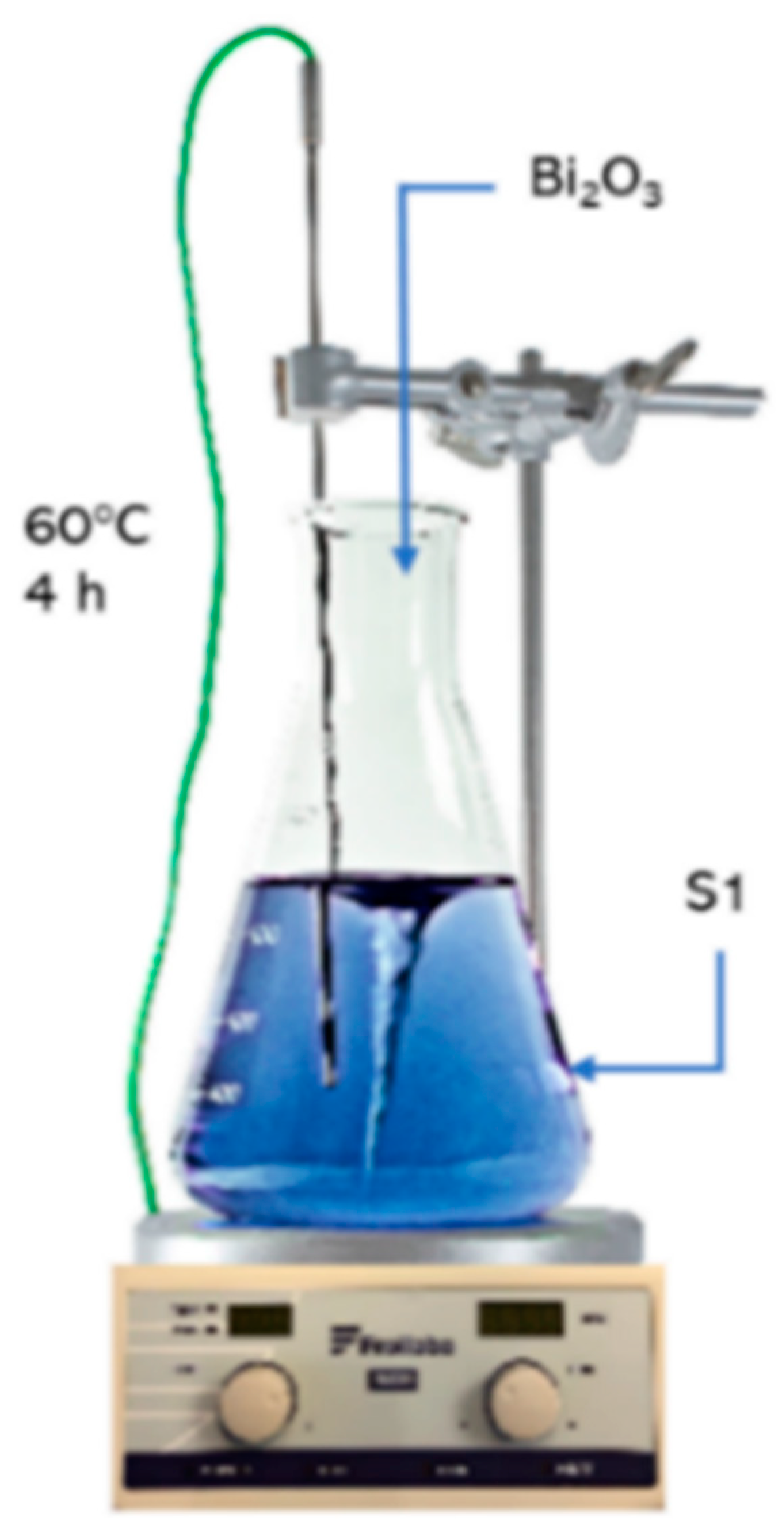
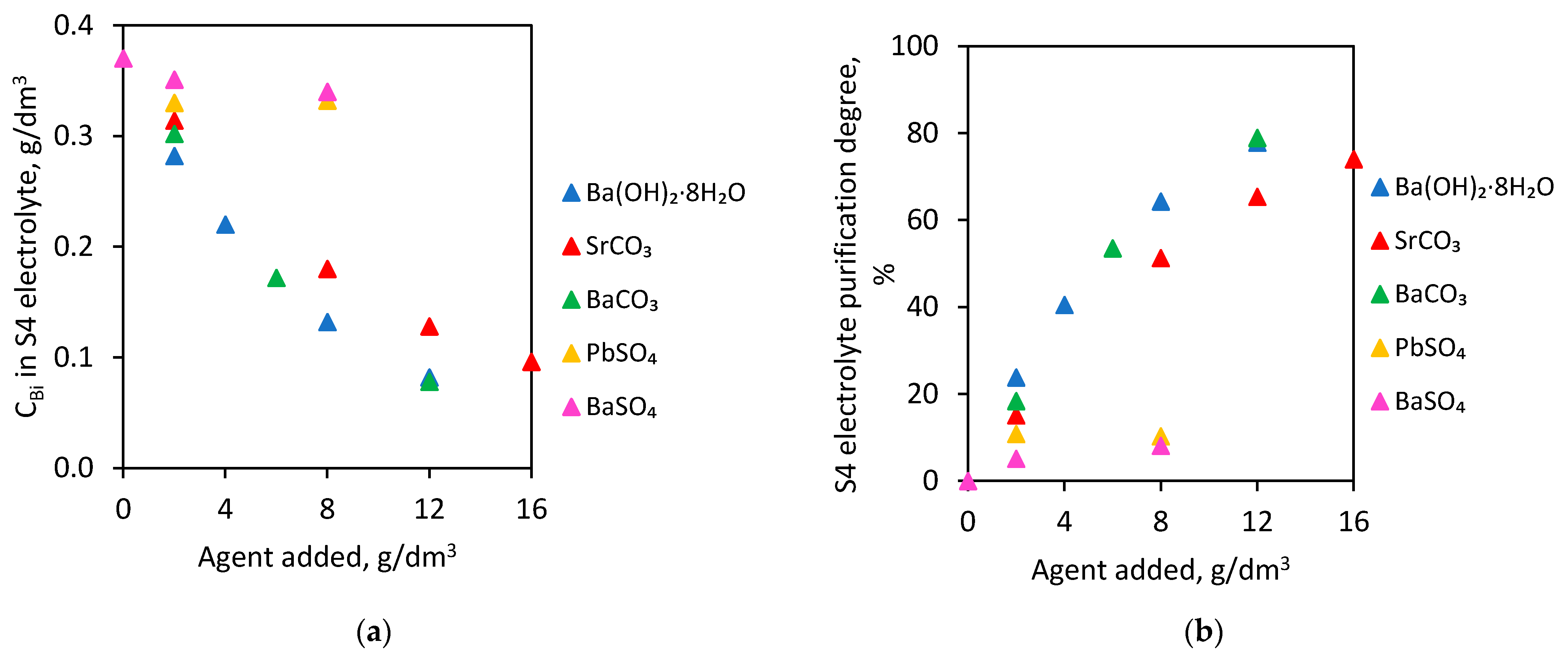

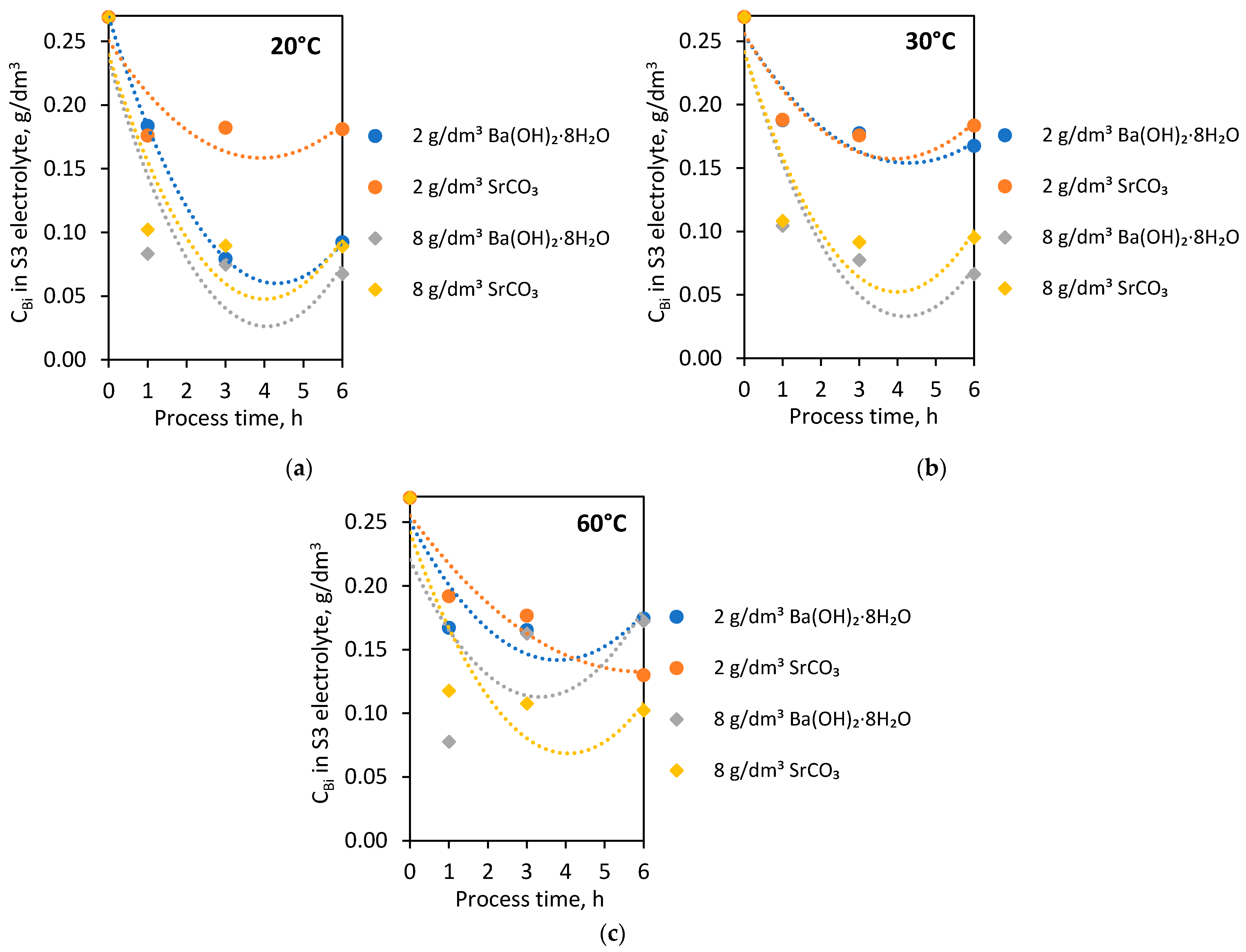
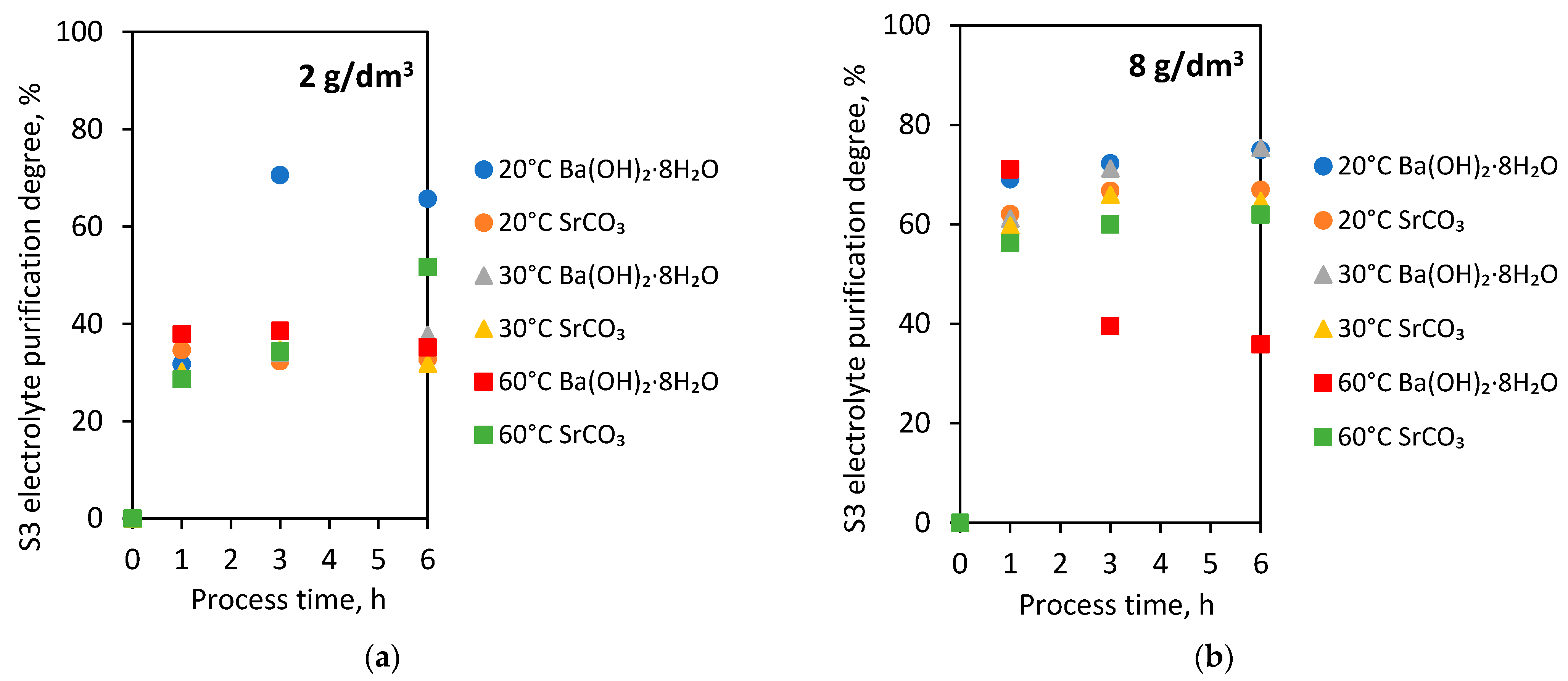
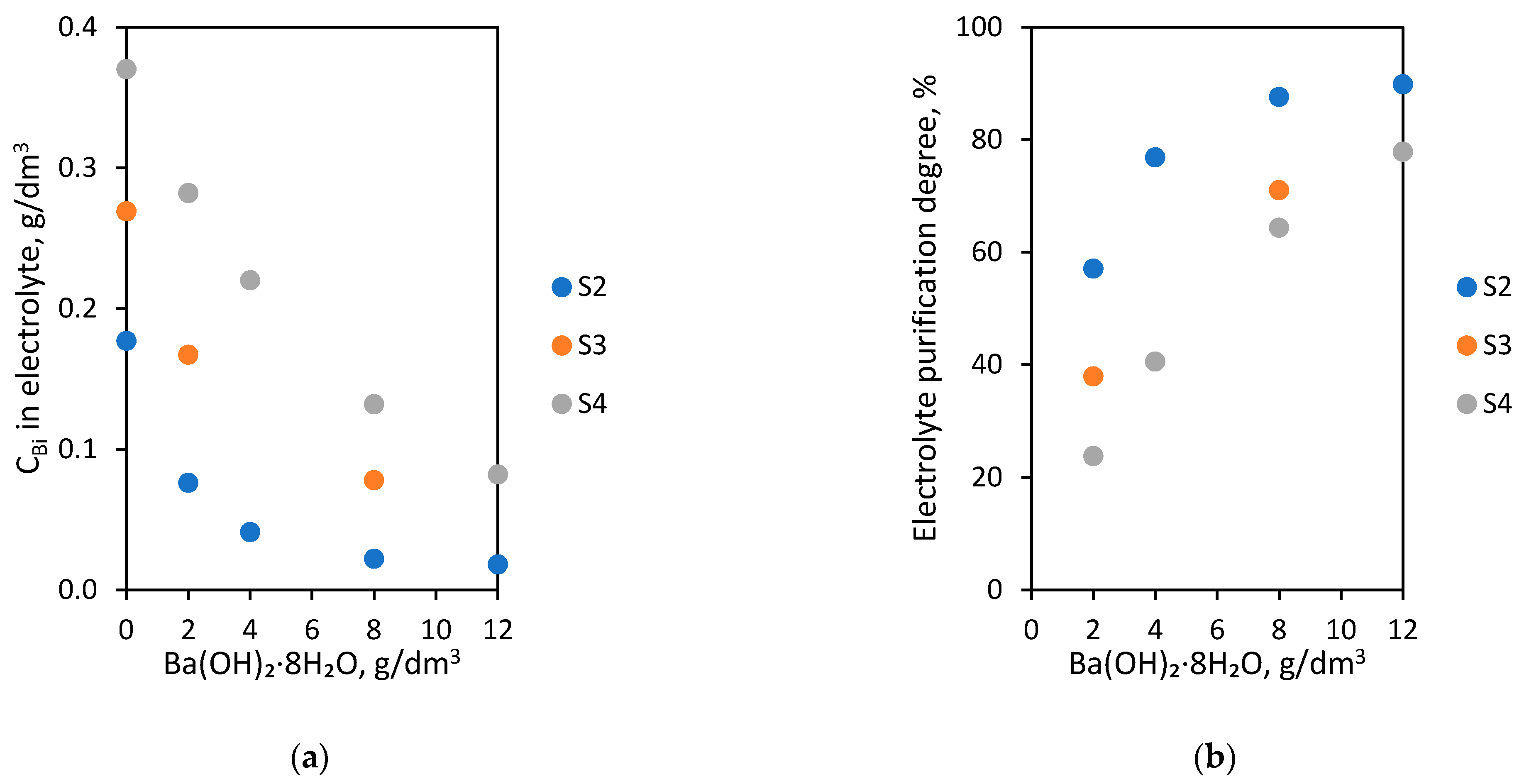
| Composition S1, g/dm3 | |||||||
|---|---|---|---|---|---|---|---|
| Cu | H2SO4 | Bi | As | Sb | Ni | Fe | Ca |
| 49.60 | 160.00 | 0.0294 | 5.75 | 0.17 | 5.40 | 0.12 | 0.38 |
| Electrolyte | Bi Concentration, g/dm3 | |
|---|---|---|
| Assumed Value | Real Value | |
| S2 | 0.2 | 0.177 |
| S3 | 0.3 | 0.269 |
| S4 | 0.4 | 0.370 |
| Agent Added, g/dm3 | Ba(OH)2∙8H2O | SrCO3 | BaCO3 | |||
|---|---|---|---|---|---|---|
| Ba ions | Purification | Sr Ions Amount, g | Purification | Ba Ions Amount, g | Purification | |
| Efficiency, | Efficiency, | Efficiency, | ||||
| Amount, g | g Bi/1 g Ba | g Bi/1 g Sr | g Bi/1 g Ba | |||
| 2 | 0.87 | 0.101 | 1.19 | 0.047 | 1.39 | 0.049 |
| 8 | 3.48 | 0.068 | 4.75 | 0.040 | - | - |
| 12 | 5.22 | 0.055 | 7.12 | 0.034 | 8.35 | 0.035 |
| 16 | 6.96 | 0.046 | 9.50 | 0.028 | - | - |
| Temperature, °C | Time, h | S3 Electrolyte Purification Degree, % | |
|---|---|---|---|
| 8 g/dm3 Ba(OH)2∙8H2O | 8 g/dm3 SrCO3 | ||
| 20 | 1 | 69.1 | 62.0 |
| 3 | 72.3 | 66.7 | |
| 6 | 74.9 | 66.9 | |
| 30 | 1 | 61.2 | 59.7 |
| 3 | 71.2 | 65.9 | |
| 6 | 75.4 | 64.7 | |
| 60 | 1 | 71.1 | 56.3 |
| 3 | 39.6 | 59.9 | |
| 6 | 35.9 | 61.9 | |
| Electrolyte | Ba(OH)2∙8H2O, g/dm3 | Bi after Purification Process, g/dm3 | Electrolyte Purification degree, % | Purification Efficiency, g Bi/1 g Ba |
|---|---|---|---|---|
| S2 | 2 | 0.076 | 57.1 | 0.116 |
| 4 | 0.041 | 76.8 | 0.078 | |
| 8 | 0.022 | 87.6 | 0.045 | |
| 12 | 0.018 | 89.8 | 0.030 | |
| S3 | 2 | 0.167 | 37.9 | 0.117 |
| 8 | 0.078 | 71.1 | 0.055 | |
| S4 | 2 | 0.282 | 23.8 | 0.101 |
| 4 | 0.220 | 40.5 | 0.086 | |
| 8 | 0.132 | 64.3 | 0.068 | |
| 12 | 0.082 | 77.8 | 0.055 |
Publisher’s Note: MDPI stays neutral with regard to jurisdictional claims in published maps and institutional affiliations. |
© 2021 by the authors. Licensee MDPI, Basel, Switzerland. This article is an open access article distributed under the terms and conditions of the Creative Commons Attribution (CC BY) license (https://creativecommons.org/licenses/by/4.0/).
Share and Cite
Kowalik, P.; Kopyto, D.; Ciszewski, M.; Drzazga, M.; Leszczyńska-Sejda, K. Purification of Industrial Copper Electrolyte from Bismuth Impurity. Minerals 2022, 12, 36. https://doi.org/10.3390/min12010036
Kowalik P, Kopyto D, Ciszewski M, Drzazga M, Leszczyńska-Sejda K. Purification of Industrial Copper Electrolyte from Bismuth Impurity. Minerals. 2022; 12(1):36. https://doi.org/10.3390/min12010036
Chicago/Turabian StyleKowalik, Patrycja, Dorota Kopyto, Mateusz Ciszewski, Michał Drzazga, and Katarzyna Leszczyńska-Sejda. 2022. "Purification of Industrial Copper Electrolyte from Bismuth Impurity" Minerals 12, no. 1: 36. https://doi.org/10.3390/min12010036
APA StyleKowalik, P., Kopyto, D., Ciszewski, M., Drzazga, M., & Leszczyńska-Sejda, K. (2022). Purification of Industrial Copper Electrolyte from Bismuth Impurity. Minerals, 12(1), 36. https://doi.org/10.3390/min12010036






